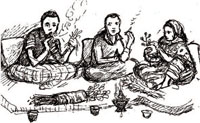Substance Abuse
As you learned in Study Session 2 of this module, adolescents and young people are vulnerable to many health problems because of their risk-taking behaviour. They tend to experiment with substances without fully understanding what the consequences are likely to be for their future life and health. In particular their curiosity and peer pressure can lead to their experimenting with psychoactive substances. A psychoactive substance affects the functions of the brain, altering mood and distorting perception. A consequence of this is that the person's behaviour changes. Repeated use of psychoactive substances can result in substance abuse Substance abuse is defined as a pattern of harmful use of any mood-altering substance. When a person becomes unable to function normally without using these substances, they are described as being addicted or dependent on the substance.

Substances that could induce dependence are numerous and include substances that are popular with young people, such as: alcohol (e.g. Tella, Tej, Arakie, Beer), khat, nicotine (found in tobacco and cigarettes), cannabis (marijuana or hashish), cocaine, heroin and petrol fumes (Figure 7.1). These substances are categorised as: 1) Licit: those which are not regulated or prohibited and 2) Illicit: those which are prohibited by law. The substances which are not prohibited by law include alcohol, khat, tobacco, cigarettes and coffee. The substances restricted by regulations include cannabis (marijuana or hashish), cocaine and heroin.
You will learn in detail about substance abuse in Study Session 14 of the Non Communicable Disease, Part 2 Module in the mental health section; here you will learn a little bit about psychoactive substances that can be abused and the consequences of substance abuse on the health of young people. Also you will find out some of the reasons why young people are tempted to try psychoactive substances and the ways in which you can work in your community to try to prevent substance abuse.